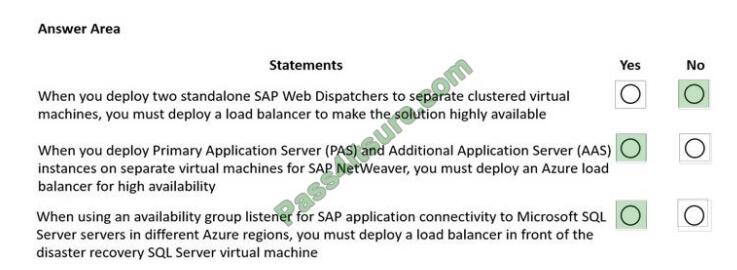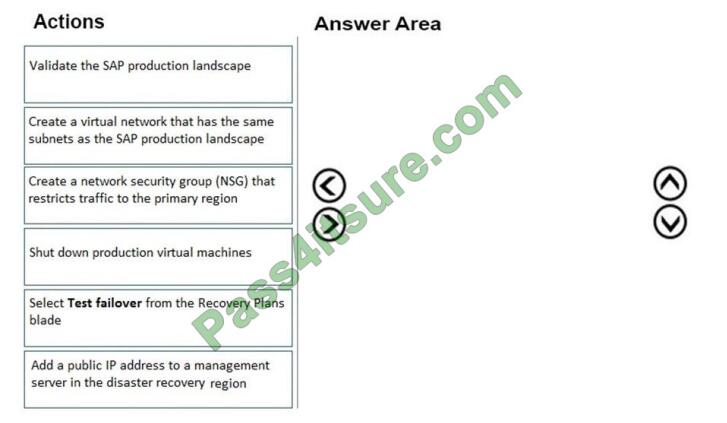If you choose the Microsoft AZ-120 exam, you will need the AZ-120 exam materials. We have updated the AZ-120 exam dumps and are the AZ-120 exam materials you need to really help you.
Pass4itSure AZ-120 exam dumps download webpage https://www.pass4itsure.com/az-120.html Once you enter, you’ll see two options to help you pass the exam.
Can understanding the Planning and Administering Microsoft Azure for SAP Workloads exam details help you prepare for the exam?
Yes, it will.
The AZ-120 exam is also known as Planning and Administering Microsoft Azure for SAP Workloads. It has 40-60 exam questions that you need to complete in 180 minutes, with multiple choice question types, and case studies. It costs $165. Successfully passing the Microsoft AZ-120 certification exam earns associate certification Microsoft Certified: Azure for SAP Workloads Specialty.
Exam Study Resources for AZ-120:
- Explore Azure for SAP workloads
- Explore the foundations of IaaS for SAP on Azure
- Explore the foundations of identity and governance for SAP on Azure
- Deploy SAP on Azure
- Ensure business continuity and implement disaster recovery for SAP solutions on Azure
- Migrate SAP workloads to Azure
- Monitor and troubleshoot Azure for SAP workloads
- Explore SAP HANA on Azure (Large Instances)
How do I pass the Microsoft AZ-120 exam easily in 2022?
First of all, it must be indispensable
Pass4itSure AZ-120 exam dumps exam materials that you must have.
Second, you need a lot of practice exam questions and answers in Microsoft AZ-120 dumps.
AZ-120 free dumps exam practice online:
Download AZ-120 free dumps here: https://drive.google.com/file/d/1rbGBnQoo4q9nybZfEB_UvV-IeXnDKxsr/view?usp=sharing
Some free practice questions and answers are as follows
QUESTION 1
HOTSPOT
You are integrating SAP HANA and Azure Active Directory (Azure AD). For each of the following statements, select Yes if the statement is true. Otherwise, select No.
NOTE: Each correct selection is worth one point.

Explanation:
Box 1: Yes
To configure Azure AD single sign-on with SAP HANA, perform the following steps:
In the Azure portal, on the SAP HANA application integration page, select Single sign-on.
On the Select a Single sign-on method dialog, select SAML/WS-Fed mode to enable single sign-on.

Box 2: No
Box 3: No Key security considerations for deploying SAP on Azure
References: https://docs.microsoft.com/en-us/azure/active-directory/saas-apps/saphana-tutorial
QUESTION 2
You migrate an SAP environment to Azure. You need to inspect all the outbound traffic from the SAP application servers to the Internet. Which two Azure resources should you use? Each correct answer presents part of the solution.
A. Network Performance Monitor
B. Azure Firewall
C. Azure Traffic Manager
D. Azure Load Balancer NAT rules
E. Azure user-defined routes
F. a web application firewall (WAF) for Azure Application Gateway
Correct Answer: BE
QUESTION 3
HOTSPOT
You plan to deploy a highly available ASCS instance to SUSE Linux Enterprise Server (SLES) virtual machines in Azure. You are configuring an internal Azure Standard Load Balancer for the ASCS instance. How should you configure the internal Standard Load Balancer? To answer, select the appropriate options in the answer area.
NOTE: Each correct selection is worth one point.
Hot Area:

Correct Answer:

Session persistence: None. Floating IP: Enabled.
References: https://docs.microsoft.com/en-us/azure/virtual-machines/workloads/sap/high-availability-guide-suse
QUESTION 4
HOTSPOT
For each of the following statements, select Yes if the statement is true. Otherwise, select No.
NOTE: Each correct selection is worth one point.
Hot Area:

Correct Answer:

Box 1: No
Load balancers. Load balancers are used to distribute traffic to virtual machines in the application-tier subnet. For high availability, use the built-in SAP Web Dispatcher, Azure Load Balancer, or network appliances. Your choice depends on the traffic type (like HTTP or SAP GUI) or the required network services, like Secure Sockets Layer (SSL) termination.
Box 2: Yes
Availability group listener SAP application SQL server load balancer disaster recovery
Box 3: Yes
Reference:
https://docs.microsoft.com/en-us/azure/architecture/reference-architectures/sap/sap-netweaver
https://docs.microsoft.com/en-us/azure/virtual-machines/workloads/sap/high-availability-guide-suse
https://blogs.sap.com/2020/10/20/sap-on-azure-sap-netweaver-7.5-on-ms-sql-server-2019-high-availability-and-disasterrecovery-with-4-nodes-alwayson-cluster/
QUESTION 5
You plan to migrate an on-premises SAP environment to Azure. You need to identify whether any SAP application servers host multiple SAP system identifiers (SLDs). What should you do?
A. Run SAP HAN A sizing report.
B. From the SAP EarlyWatch Alert report, compare the physical host names to the virtual host names.
C. Run the SAP Report from ABAPMeter.
D. From the SAP EarlyWatch Alert report, compare the services to the reference objects
Correct Answer: C
QUESTION 6
HOTSPOT
You have SAP ERP on Azure. For SAP high availability, you plan to deploy ASCS/ERS instances across Azure Availability Zones and to use failover clusters. For each of the following statements, select Yes if the statement is true. Otherwise, select No.
NOTE: Each correct selection is worth one point.

Box 1: No
You can\’t use an Azure Basic Load Balancer to create failover cluster solutions based on Windows Server Failover Clustering or Linux Pacemaker. Instead, you need to use the Azure Standard Load Balancer SKU.
Box 2: Yes
Azure Availability Zones is one of the high-availability features that Azure provides. Using Availability Zones improves the overall availability of SAP workloads on Azure. The SAP application layer is deployed across one Azure availability set. For the high availability of SAP Central Services, you can deploy two VMs in a separate availability set.
Box 3: Yes
You must use Azure Managed Disks when you deploy to Azure Availability Zones.
Reference:
https://docs.microsoft.com/en-us/azure/virtual-machines/workloads/sap/sap-ha-availability-zones
QUESTION 7
You have an SAP Cloud Platform subscription and an Azure Active Directory (Azure AD) tenant. You need to ensure that Azure AD users can access SAP Cloud App by using their Azure AD credentials. What should you configure?
A. Active Directory Domain Services (AD DS)
B. SAP Cloud Platform Identity Authentication
C. A conditional access policy
D. SAP Cloud Connector
Correct Answer: A
When you integrate SAP Cloud Platform Identity Authentication with Azure AD, you can:
1. Control in Azure AD who has access to SAP Cloud Platform Identity Authentication.
2. Enable your users to be automatically signed in to SAP Cloud Platform Identity Authentication with their Azure AD accounts.
3. Manage your accounts in one central location – the Azure portal.
QUESTION 8
DRAG DROP
You have an SAP environment on Azure. You use Azure Site Recovery to protect an SAP production landscape. You need to validate whether you can recover the landscape in the event of a failure. The solution must minimize the impact on the landscape. Which four actions should you perform in sequence? To answer, move the appropriate actions from the list of actions to the answer area and arrange them in the correct order.
Select and Place:

Correct Answer:

Step 1: Create a virtual network…
We recommended that for test failover, you choose a network that\\’s isolated from the production recovery site network specific in the Compute and Network settings for each VM. By default, when you create an Azure virtual network, it is isolated from other networks. The test network should mimic your production network:
The test network should have the same number of subnets as your production network. Subnets should have the same names. The test network should use the same IP address range.
Step 2: Add a public IP address…
Because Site Recovery does not replicate the cloud witness, we recommend that you deploy the cloud witness in the disaster recovery region.
Step 3: Shut down production virtual machines
Make sure that the primary VM is shut down when you run the test failover. Otherwise, there will be two VMs with the same identity, running in the same network at the same time. This can lead to unexpected consequences.
Step 4: Select Test failover from the Recovery Plans blade
Reference:
https://docs.microsoft.com/en-us/azure/site-recovery/site-recovery-test-failover-to-azure
QUESTION 9
You need to recommend a solution to reduce the cost of the SAP non-production landscapes after the migration. What should you include in the recommendation?
A. Configure scaling of Azure App Service
B. Migrate the SQL Server databases to Azure SQL Data Warehouse
C. Deallocate virtual machines when not in use
D. Deploy non-production landscapes to Azure DevTest Labs
Correct Answer: A
References: https://docs.microsoft.com/en-us/azure/architecture/example-scenario/apps/sap-dev-test
QUESTION 10
You deploy an SAP landscape on Azure. You plan to use an Azure Automation account to stop the SAP virtual machines outside of business hours. You need to ensure that you can use Azure Automation runbook for the virtual machines. What does the Azure Automation account require?
A. an Azure Storage account
B. an Azure App Service WebJob
C. a Recovery Services vault
D. a Run As an account
Correct Answer: B
QUESTION 11
Litware is evaluating whether to add high availability after the migration What should you recommend to meet the technical requirements?
A. SAP HANA system replication and Azure Availability Sets
B. Azure virtual machine auto-restart with SAP HANA service auto-restart.
C. Azure Site Recovery
Correct Answer: A
QUESTION 12
HOTSPOT
You have an SAP landscape on Azure. You plan to deploy a new SAP application server by using an Azure Resource Manager template. You need to ensure that all new servers are deployed with Azure Disk Encryption enabled.
How should you complete the relevant component of the template? To answer, select the appropriate options in the answer area.
NOTE: Each correct selection is worth one point.
Hot Area:

Correct Answer:

Box 1: extensions
Azure Disk Encryption can be enabled via Azure PowerShell or Azure CLI. That is normally seen in remediation. In a real-world scenario, you would like to see a virtual machine during its creation including the disk encryption process. This is technically possible thanks to the Disk Encryption VM extension.
Box 2: AzureDiskEncryption
Example:
..
“type”: “Microsoft.Compute/virtualMachines/extensions”,
“name”: “[concat(parameters(\’vmName\’),\’/diskEncryption\’)]”,
“apiVersion”: “2019-03-01”,
“location”: “[parameters(\’location\’)]”,
“dependsOn”: [
“[resourceId(\’Microsoft.Compute/virtualMachines/\’, parameters(\’vmName\’))]”
],
“properties”: {
“publisher”: “Microsoft.Azure.Security”, “type”: “AzureDiskEncryption”, ..
Reference: https://azsec.azurewebsites.net/2019/12/28/azure-disk-encryption-arm-template-for-windows-vm/
QUESTION 13
HOTSPOT
You are planning the Azure network infrastructure for an SAP environment. For each of the following statements, select Yes if the statement is true. Otherwise, select No.
NOTE: Each correct selection is worth one point.
Hot Area:

Box 1: NO
Box 2: Yes
Box 3: Yes Be aware that network traffic between two peered Azure virtual networks is subject to transfer costs. A huge data volume that consists of many terabytes is exchanged between the SAP application layer and the DBMS layer. You can accumulate substantial costs if the SAP application layer and DBMS layer are segregated between two peered Azure virtual networks.
References: https://docs.microsoft.com/en-us/azure/virtual-machines/workloads/sap/dbms_guide_general
Use the Pass4itSure AZ-120 exam dumps https://www.pass4itsure.com/az-120.html as study material for the Planning and Administering Microsoft Azure for SAP Workloads exam to help you pass the exam
Finally, I wish you all a happy study and all the best for your exams.